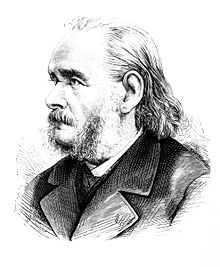Matthias Jakob Schleiden (5 April 1804 – 23 June 1881) was a German botanist. He was long supposed to be the co-founder of the cell theory, with Theodor Schwann and Rudolf Virchow. However, a recent study of the original papers revealed that Schleiden and Schwann used previous research, and were popularisers of an idea others had discovered.
Matthias Jakob Schleiden | |
|---|---|
 | |
| Born | 5 April 1804 |
| Died | 23 June 1881 (aged 77) |
| Nationality | German |
| Alma mater | Heidelberg |
| Known for | Cell theory |
| Scientific career | |
| Institutions | University of Jena, University of Dorpat |
| Author abbrev. (botany) | Schleid. |
Modern assessment
changeThe earlier work of the Czech Jan Purkyně (1787–1869) and his student and collaborator Gabriel Valentin (1810–1883) was "unjustly denigrated by the nationalistic Germans. They have a claim to some priority in the cell theory".[1]Chapter 9
Johannes Müller (1801–1858) also made great contributions. It was, however, his student Theodor Schwann and Matthias Schleiden who got the credit for the cell theory. This was despite the fact that some of their observations were not correct, and their credits to previous workers were "a travesty".[1]p97 As understood now, the cell theory includes these important ideas:
- All living things are made of cells.
- The cell is the basic unit of structure and function in all organisms.
- Every cell comes from another cell that lived before it.
- The nucleus is the core element of the cell.
The key works of Schwann and Schleiden were published in 1838 and 1839.[2] These ideas still are the basic ideas of cell theory.[3]
References
change- ↑ 1.0 1.1 Harris H. 1999. The birth of the cell. Yale University Press, New Haven.
- ↑ Schwann, Theodor 1847 [1839]. Microscopic investigations on the accordance in the structure and growth of plants and animals. London: Sydenham Society.
- ↑ Gall JG & McIntosh JR eds 2001. Landmark papers in cell biology. Bethesda MD and Cold Spring Harbor NY: The American Society for Cell Biology and Cold Spring Harbor Laboratory Press.